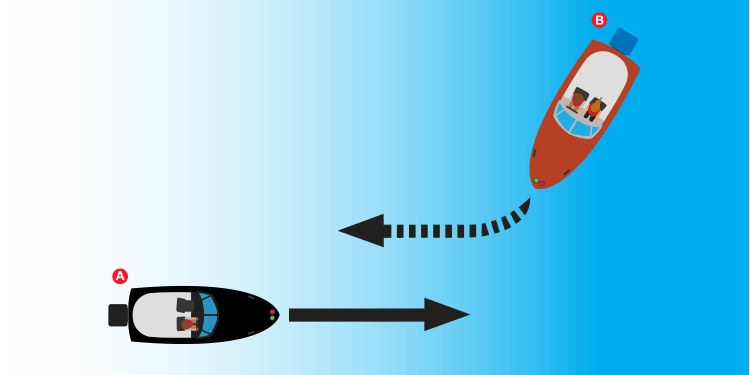
The stand-on vessel is the vessel which currently has the right of way. The power-driven vessel is the give-way vessel.

The sail boat should give way to the power boat.
When a sailboat is approaching a powerboat which one is the give way vessel. When two sailing vessels are approaching one another with the wind on different sides the sailing vessel with the wind on its starboard right side is the stand-on vessel. The vessel on the operators port left side is the give way vessel. The vessel on the operators starboard right side is the stand-on vessel.
When only a red light is visible it means one is approaching a sailboat on its port side. Give way to ones starboard sideSailboat B. When white and green lights are visible it means one is approaching the starboard side of a powered-vessel.
Which is the give-way boat. Right off we apply the rule that a power-driven boat is the give-way vessel and the sailboat under sail that is should stand on. But if the sailboat is under power then its treated like any other power-driven boat.
Which brings us to scenario two. Powerboat versus powerboat head-on. So which one is the give-way vessel.
The give-away vessel may however take action to avoid collision if it is clear that the vessel which should be keeping out of the way is not taking appropriate action. A power-driven vessel underway shall keep out of the way of. A vessel not under command.
A vessel restricted in her ability to manoeuvre. A fishing boat hauling its nets. 2 powerboats approaching each other.
Each boat is the give way - pass port-to-port to the right powerboat approaching sailboat. Powerboat is give way boat sailboat is stand on boat it doesnt have as much control over their boat. The stand-on vessel is the vessel which currently has the right of way.
In the event of two vessels approaching one another the stand-on vessel has three obligations. The stand-on vessel must maintain its current speed and course keep a lookout and stay alert and look out for and return any communication from the give-way. When two sailing vessels are approaching one another with the wind on the same side the leeward sailing vessel is the stand-on vessel.
Wind on Different Side When two sailing vessels are approaching one another with the wind on different sides the sailing vessel with the wind on its starboard right side is the stand-on vessel. When is your powerboat the give-way vessel. When crossing a boat that is sailing and not using its engine Where can you find the type of measurement units ie feet meters fathoms used on a chart.
If a powerboat is about to cross paths with a sailboat under sail give way the sail boat is the stand-on vessel therefore you are the give-way vessel and need to move accordingly. When a sailboat is approaching a powerboat which one is the give way vessel. Ben Davis May 18 2019.
When a sailboat is approaching a powerboat which one is the give way vessel. Which is the give way vessel Boat Ed. The sailing vessel is the stand-on vessel.
When a sailboat is approaching a power boat. When a power-driven vessel B encounters a sailing vessel A the sailing vessel is ALWAYS the stand-on vessel unless a sailing vessel is overtaking. In the case above power-driven vessel B must take EARLY and SUBSTANTIAL action to keep clear of sailing vessel A.
When a sail boat is approaching a powerboat which one is the give-way vessel. The vessel that has the greatest ability to get out of the way of the other one has the duty to do that. What should the operator of a give-way vessel do to avoid colliding with a stand-on vessel.
Take early and substantial action to stay well clear Which of these causes most collisions. When a sailboat is approaching a powerboat which one is the give way vessel. A power boat cannot stop or turn as fast especially a vessel larger than the sail boat.
The sail boat should give way to the power boat. A sailboat with the engine running is a powerboat even if the sails are up. If boats are about the same size the power boat gives way.
If one boat is much larger than the other the larger vessel can be assumed to be less maneuverable if they are near shore or near each other. The more maneuverable vessel is the give-way vessel. This normally means the smallest one.
But all captains are responsible for avoiding collisions on the water. When would a sailboat be the give way vessel. The power-driven vessel is the give-way vessel.
The sailing vessel is the stand-on vessel. The vessel that is overtaking another vessel is the give-way vessel regardless of whether it is a sailing vessel or a power-driven vessel. What is a sailboat the stand on vessel in relations to a recreational powerboat.
The stand-on vessel is the one that is on the starboard side of a boat and its red light or streamer is visible to you. The situation where a sailboat would be the stand-on vessel will be then the sailboat is overtaking the power boat. When a sailboat overtakes a powerboat the powerboat is the stand-on vessel.
In the Navigational rules the boat that overtakes another one is the give-way vessel and the boat being overtaken is the stand-on vessel. In the Collision Regulations a sailboat is called a sailing vessel and a power boat recreational or otherwise is called a power driven vessel. A sailing always has right of way ie.
Is the stand on vessel over a power driven vessel except when Rule 18 the power driven vessel is. Remember that a sailboat running an engine even if sails are up is legally categorized as a powerboat. In most situations the sailing boat is the stand-on vessel and the powerboat must give way.